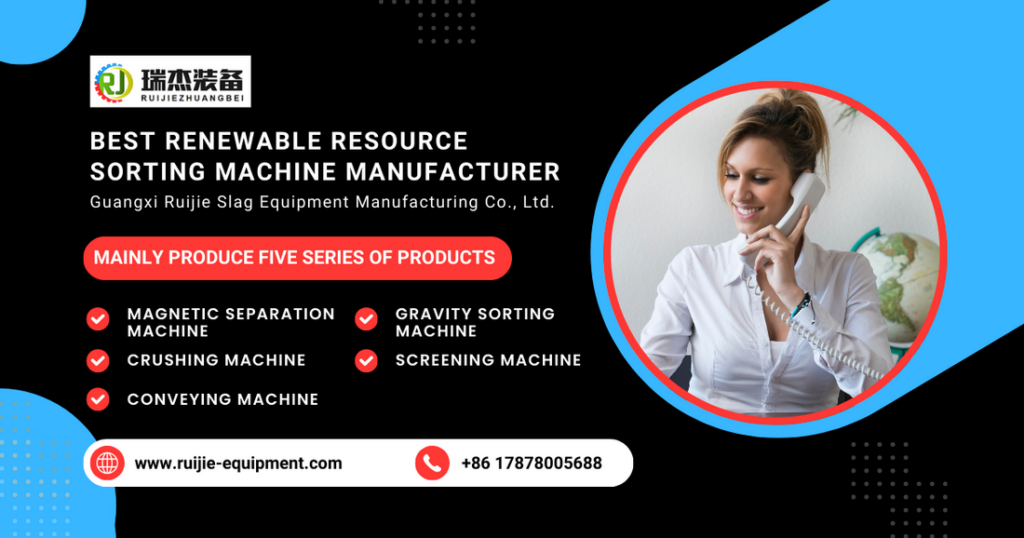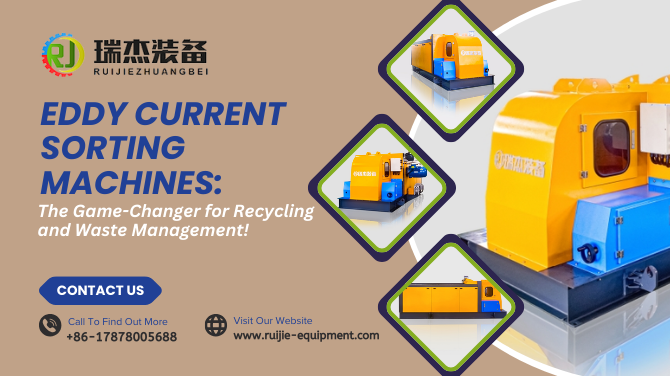In an era where sustainability and environmental responsibility are more critical than ever, the need for efficient recycling methods is at an all-time high. Industries, governments, and consumers alike are looking for innovative ways to minimize waste and maximize the recovery of valuable materials. One such groundbreaking technology that has emerged as a game-changer in recycling is the eddy current sorting machine.
At Guangxi Ruijie Slag Equipment Manufacturing Co., Ltd., we specialize in providing high-quality, advanced machinery solutions designed to enhance the efficiency of industrial processes. Our eddy current sorting machines are specifically engineered to revolutionize the recycling and waste management sectors. By leveraging the principles of electromagnetism, these machines offer an unmatched level of precision in separating non-ferrous metals from mixed waste materials, thereby significantly improving recycling processes and contributing to a cleaner, more sustainable future.
What is an Eddy Current Sorting Machine?
An eddy current sorting machine is a specialized piece of equipment used to separate non-ferrous metals, such as aluminum, copper, and brass, from mixed waste or recyclable materials. The core principle behind the machine’s operation is eddy currents—circular electric currents induced in conductive materials when exposed to a changing magnetic field. This technology takes advantage of the fact that non-ferrous metals have different magnetic properties compared to other materials, allowing for efficient sorting.
Through the use of a rotating magnetic drum or conveyor system, the eddy current sorting machine generates a rapidly changing magnetic field. As materials pass through this field, non-ferrous metals are subjected to strong repulsive forces, causing them to be ejected from the rest of the material stream. This separation process occurs with high speed and precision, making it ideal for large-scale recycling operations.
The Mechanics Behind Eddy Current Separation
The operation of an eddy current sorting machine involves several key components working together to achieve the desired results:
Magnetic Rotor
The core of the machine is its magnetic rotor, which creates the high-frequency alternating magnetic field. This rotor is responsible for inducing the eddy currents in non-ferrous metals, enabling them to be repelled from the material flow.
Separation Process
Once the eddy currents are induced, the non-ferrous metals experience a repulsive force from the magnetic field. This force causes the metals to be ejected from the main material stream and collected separately.
Residue Management
The remaining materials, which may consist of ferrous metals and non-metallic materials, continue along the conveyor for further processing or disposal.
Why Eddy Current Sorting Machines Are Essential for Recycling
Eddy current sorting machines are a vital tool for modern recycling facilities due to their ability to increase both efficiency and profitability. Below are several reasons why they are becoming indispensable in the recycling and waste management sectors:
Increased Recovery of Non-Ferrous Metals
One of the key benefits of eddy current sorting machines is their ability to separate non-ferrous metals with high accuracy. These metals, such as aluminum, copper, and zinc, are valuable and can be recycled multiple times without losing their quality. By efficiently recovering these materials, recycling plants can generate more revenue from the processed waste.
Minimizing Contamination
In the recycling process, contamination can severely affect the quality of the end products. By using an eddy current sorting machine, recyclers can minimize contamination by efficiently removing ferrous and non-metallic materials that would otherwise degrade the quality of the final product.
Environmental Benefits
Eddy current sorting machines contribute to a cleaner environment by reducing waste and promoting the recycling of valuable metals. This technology helps reduce the reliance on mining, conserving natural resources and minimizing the carbon footprint associated with the extraction of new materials.
Energy Efficiency
Compared to traditional sorting methods, eddy current sorting machines are more energy-efficient. Since they use a rotating magnetic field, there is minimal need for external power sources, reducing overall energy consumption in the recycling process.
Applications of Eddy Current Sorting Machines
The versatility of eddy current sorting machines makes them suitable for various applications in different industries. Let’s examine a few of the most popular applications:
Aluminum Recycling
Aluminum is one of the most commonly recycled metals due to its high recyclability and value. Eddy current sorting machines are widely used to recover aluminum from mixed waste streams, including scrap metal, consumer goods, and packaging materials.
E-Waste Recycling
E-waste recycling is a growing industry due to the increasing amount of electronic waste generated globally. Eddy current sorting machines play a critical role in recovering precious non-ferrous metals, such as gold, copper, and silver, from discarded electronic devices.
Automotive Recycling
Automotive recycling involves the processing of end-of-life vehicles (ELVs), which contain a variety of metals, plastics, and other materials. Eddy current sorting machines help recover non-ferrous metals from scrap vehicles, such as aluminum engine parts and copper wiring.
Municipal Solid Waste (MSW) Recycling
Municipal solid waste consists of various types of materials, including paper, plastics, and metals. Eddy current sorting machines are often used in the sorting of mixed waste streams, particularly for extracting non-ferrous metals from the waste.
Advantages of Eddy Current Sorting Machines Over Other Methods
Eddy current sorting machines offer several advantages over traditional sorting methods, including magnetic separation and manual sorting.
Speed and Efficiency
Eddy current sorting is significantly faster than manual sorting, which is time-consuming and labor-intensive. This increased speed leads to higher throughput and productivity in recycling plants.
Precision
The precision of eddy current sorting machines allows for the removal of even small non-ferrous metal particles, which may be difficult to detect and separate using other methods. This results in cleaner, more valuable output.
Cost-Effectiveness
Although the initial investment in eddy current sorting machines can be significant, the long-term cost savings due to higher recovery rates and reduced labor costs make them a cost-effective choice for many recycling operations.

Why Choose Guangxi Ruijie Slag Equipment Manufacturing Co., Ltd. for Your Eddy Current Sorting Needs?
At Guangxi Ruijie Slag Equipment Manufacturing Co., Ltd., we are committed to providing state-of-the-art recycling equipment, including high-performance eddy current sorting machines. With years of expertise in the slag and metal separation industry, we design and manufacture sorting machines that meet the highest standards of efficiency and reliability.
Our eddy current sorting machines are built with advanced technology to ensure that non-ferrous metals are separated with exceptional accuracy. By choosing our products, recycling plants can achieve superior results, minimize waste, and increase profitability.
The Future of Eddy Current Sorting in Recycling
As the demand for efficient recycling solutions continues to grow, eddy current sorting machines are expected to evolve to meet new challenges. Innovations in magnetic materials, sensor technology, and automation will likely improve the performance and versatility of these machines, making them even more effective in a wider range of applications.
Additionally, as global recycling standards become more stringent, the role of eddy current sorting machines in ensuring high-quality output will become even more critical.
The rise of eddy current sorting machines marks a significant advancement in the recycling industry. These machines are not only capable of increasing the recovery rates of valuable non-ferrous metals, but they also help reduce waste, conserve natural resources, and lower energy consumption. As the world moves toward a more sustainable future, technologies like eddy current sorting machines will continue to play a vital role in transforming the recycling and waste management sectors.
At Guangxi Ruijie Slag Equipment Manufacturing Co., Ltd., we are proud to offer innovative solutions that help companies achieve greater efficiency, profitability, and sustainability in their recycling operations. By incorporating eddy current sorting technology into your processes, you can ensure that your facility remains at the forefront of the recycling industry.
Frequently Asked Questions
- 1. How does an eddy current sorting machine work?
An eddy current sorting machine works by inducing circular electric currents (eddy currents) in non-ferrous metals when they pass through a changing magnetic field. This generates a repulsive force that separates the metals from the rest of the material stream.
- 2. What materials can be sorted using an eddy current sorting machine?
Eddy current sorting machines are primarily used to separate non-ferrous metals, such as aluminum, copper, and brass, from other materials.
- 3. Can eddy current sorting machines be used for large-scale recycling?
Yes, eddy current sorting machines are designed to handle large volumes of waste materials and are commonly used in high-throughput recycling facilities.
- 4. Are there any maintenance requirements for eddy current sorting machines?
Maintenance is minimal, but regular cleaning of the conveyor belt and checking for wear on key components such as the rotor is recommended to ensure optimal performance.
- 5. How do eddy current sorting machines contribute to environmental sustainability?
By improving the recovery of valuable metals and reducing waste, eddy current sorting machines help conserve natural resources and minimize the environmental impact of industrial waste.



